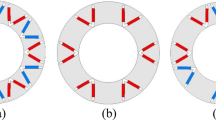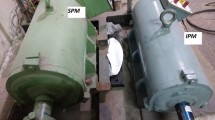Abstract
This paper investigates the influence of different magnetization patterns in the performance of three-phase permanent magnet synchronous motors (PMSMs). Three magnetization patterns widely used in surface-mounted PMSMs are radial magnetization, parallel magnetization and Halbach magnetization. In this paper, these magnetization patterns are applied to 9-slot/10-pole and 12-slot/10-pole surface-mounted PMSMs. The electromagnetic characteristics and performance of the motors such as air gap flux density distributions, phase back-emf, cogging torque, unbalance magnetic force and output torque are intensively evaluated in 2D finite element method. Important findings indicate that PMSMs with ideal Halbach magnetization exhibit almost zero cogging torque and sinusoidal phase back-emf waveform. Parallel magnetization and radial magnetization yield more trapezoidal phase back-emf waveform which results in higher torque ripples. One way to minimize the torque ripples is by reducing the higher-order harmonic components in the phase back-emf waveform which can be achieved with the best value of magnet pole arc. Additionally, a potential cost saving can be realized since the motor has smaller magnet volume as being demonstrated in the case of 9-slot/10-pole, three-phase surface-mounted PMSM in this paper.













Similar content being viewed by others
References
Choi JS, Yoo J (2010) Optimal design method for magnetization directions of a permanent magnet array. J Magn Magn Mater 322(8):2145–2151
Rahideh A, Korakianitis T (2012) Analytical magnetic field calculation of slotted brushless permanent-magnet machines with surface inset magnets. IEEE Trans Magn 48(10):2633–2649
MiyamasuM, AkatsuK (2012) A study of high torque surface-mounted permanent magnet synchronous motor by maximum utilization of the magnet flux. In: 15th international conference on electrical machines and systems (ICEMS). Sapporo, Japan, pp 1–6
Pfister PD, Perriard Y (2011) Slotless permanent-magnet machines: general analytical magnetic field calculation. IEEE Trans Magn 47(6):1739–1752
Atallah K, Zhu ZQ, Howe D (1998) Armature reaction field and winding inductances of slotless permanent-magnet brushless machines. IEEE Trans Magn 34(5):3737–3744
Rahideh A, Korakianitis T (2013) Analytical calculation of open-circuit magnetic field distribution of slotless brushless PM machines. Int J Electr Power Energy Syst 44(1):99–114
Petkovska L, Cvetkovski GV, Lefley P (2016) Study of the performance characteristics of a surface permanent magnet motor at various magnetization patterns. COMPEL Int J Comput Math Electr Electron Eng 35(6):1910–1924
Hua W, Su P, Shi M, Zhao G, Cheng M (2015) The influence of magnetizations on bipolar stator surface-mounted permanent magnet machines. IEEE Trans Magn 51(3):1–4
Shen Y, Zhu ZQ (2013) General analytical model for calculating electromagnetic performance of permanent magnet brushless machines having segmented Halbach array. IET Electr Syst Transp 3(3):57–66
Rahideh A, Korakianitis T (2011) Analytical magnetic field distribution of slotless brushless machines with inset permanent magnets. IEEE Trans Magn 47(6):1763–1774
Zhu ZQ, Xia ZP, Howe D (2002) Comparison of Halbach magnetized brushless machines based on discrete magnet segments or a single ring magnet. IEEE Trans Magn 38(5):2997–2999
Ahmad MS, Manap NAA, Ishak D (2008) Permanent magnet brushless machines with minimum difference in slot number and pole number. In: 2nd international conference on power and energy 2008 (PECON 2008). Johor Bharu, Malaysia, pp 1064–1069
Rahideh A, Korakianitis T (2012) Analytical magnetic field distribution of slotless brushless PM motors. Part 2: open-circuit field and torque calculations. IET Electr Power Appl 6(9):639–651
Zhu ZQ, Howe D, Chan CC (2002) Improved analytical model for predicting the magnetic field distribution in brushless permanent-magnet machines. IEEE Trans Energy Convers 15(4):407–412
Zhu ZQ, Ruangsinchaiwanich S, Ishak D, Howe D (2005) Analysis of cogging torque in brushless machines having nonuniformly distributed stator slots and stepped rotor magnets. IEEE Trans Magn 41(10):3910–3912
Dorrell DG, Popescu M, Cossar C, Ionel D (2008) Unbalanced magnetic pull in fractional-slot brushless PM motors. IEEE industry applications society annual meeting 2008. Edmonton, AB, Canada, pp 1–8
Jang SM, Lee SH, Cho HW, Cho SK (2003) Analysis of unbalanced force for high-speed slotless permanent magnet machine with halbach array. IEEE Trans Magn 39(5):3265–3267
Acknowledgements
The authors would like to express their gratitude and thank to Universiti Sains Malaysia and Ministry of Higher Education Malaysia for the financial support under grant number FRGS/1/2015/TK04/USM/02/1.
Author information
Authors and Affiliations
Corresponding author
Rights and permissions
About this article
Cite this article
Ishak, D., Rezal, M. & Tiang, T.L. Influence of magnetization pattern in three-phase permanent magnet synchronous machines. Electr Eng 100, 2667–2676 (2018). https://doi.org/10.1007/s00202-018-0738-0
Received:
Accepted:
Published:
Issue Date:
DOI: https://doi.org/10.1007/s00202-018-0738-0




